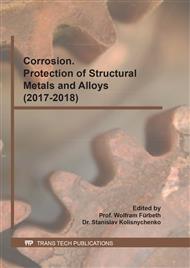p.1607
p.1613
p.1618
p.1625
p.1632
p.1639
p.1645
p.1651
p.1656
Stress Gradient Determination in Anti-Corrosion Multilayer Coating
Abstract:
To reduce maintenance and to increase the corrosion protection and lifetime of maritimestructures while complying with environmental standards, multilayer coatings are applied to protectsteel sections. A new generation of hybrid sol-gel and/or HiPIMS Ni-based thin films appear toconstitute an efficient pre-treatment before the anti-corrosion paint application. However, increasingthe number of coatings and associated interfaces may lead to coating failure due to stresses inducedby the different deposition processes. Therefore developing smart models to assess the stressdistribution along these multilayers appears of significant importance. The well-known Stoneyformula cannot be used for multilayers and owing to the large dimensions of the object to be protected.To assess an easily measurable curvature after deposition, thin steel sheets are used but do not respectany more the Stoney hypotheses. So we set up an analytical thermo-elasto-plastic model to evaluatethe stresses induced by depositions in each layer. This model is based on the various thermalexpansion coefficients of every coat. After extrapolation along the complete thickness, combiningsol-gel and PVD deposition smoothens the stress difference between steel and paint. The shearstresses at interface seems thus to be reduced. The evolution of the stress difference between layerswith the imposed deflection can predict the mechanical strength and the interface failure. In order toevaluate the quality of the model, in-situ four-point bending in SEM was performed to study of theadhesion between the various layers. The results deduced from the model are in good agreement withSEM images.
Info:
Periodical:
Pages:
1632-1638
Citation:
Online since:
December 2018
Price:
Сopyright:
© 2018 Trans Tech Publications Ltd. All Rights Reserved
Share:
Citation:



